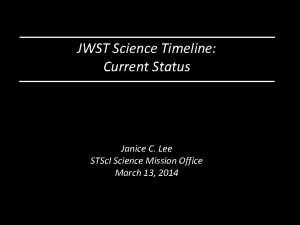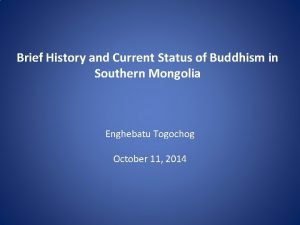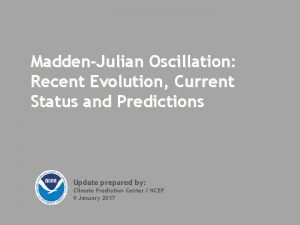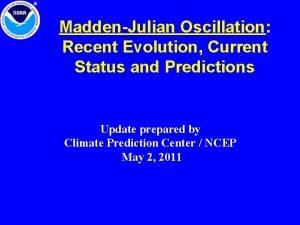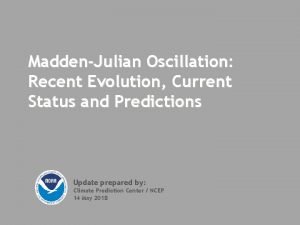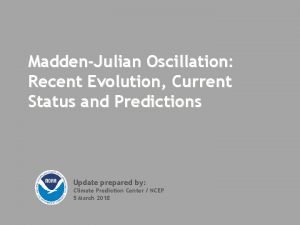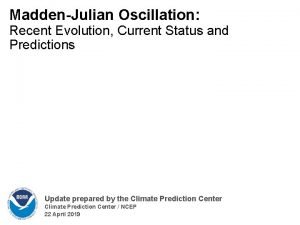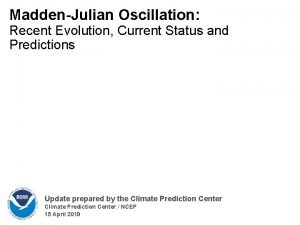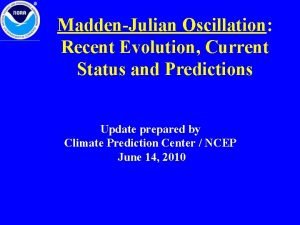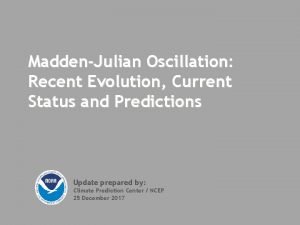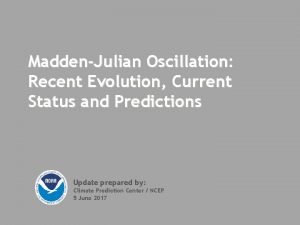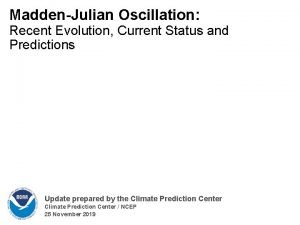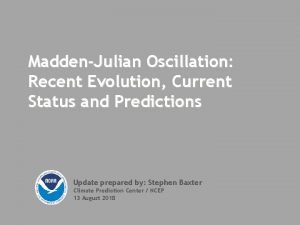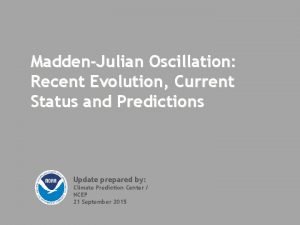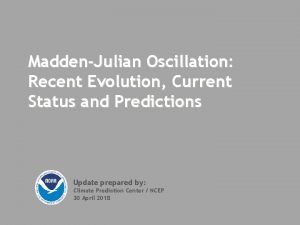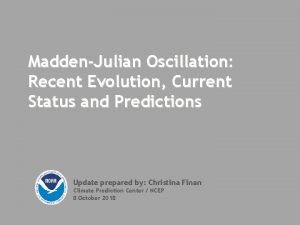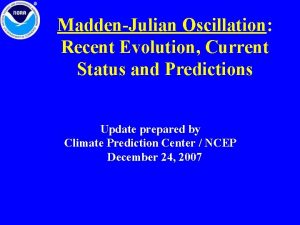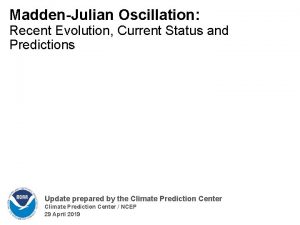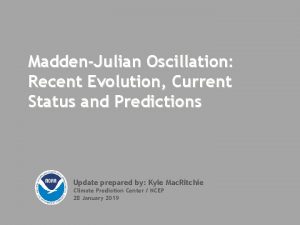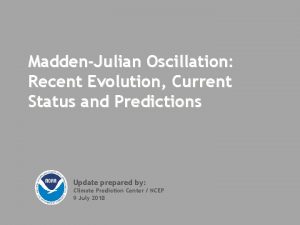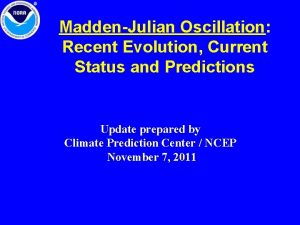MaddenJulian Oscillation Recent Evolution Current Status and Predictions





















- Slides: 21

Madden-Julian Oscillation: Recent Evolution, Current Status and Predictions Update prepared by Climate Prediction Center / NCEP February 11, 2013

Outline • Overview • Recent Evolution and Current Conditions • MJO Index Information • MJO Index Forecasts • MJO Composites

Overview • The MJO remained active over the past week with the enhanced convective phase centered across Africa and approaching the Indian Ocean. • There is good agreement in dynamical model MJO index forecasts for the continuation of a MJO signal, although this is likely influenced by atmospheric Kelvin wave activity as eastward propagation in the forecasts is fast as compared to canonical MJO activity. • Based on recent observations and MJO index forecasts, the MJO is forecast to remain active during the next two weeks with the enhanced phase crossing the Indian Ocean and entering the Maritime continent over the period. • The MJO favors enhanced rainfall for parts of Southeast Africa (Week-1) and the eastern Indian Ocean and Maritime continent (Weeks 1 -2) during the period, while suppressed rainfall is favored for portions of the western Pacific, primarily Week-1. The MJO also supports elevated chances of tropical cyclogenesis for areas in the southern Indian Ocean. • For the U. S. , the MJO favors, on average, the development of a mean trough across the western U. S. just after mid-February suggesting elevated chances for below normal temperatures. As we approach the end of February, the MJO would favor troughing near or along the west coast and a tendency toward a mean ridge across the eastern U. S. . Additional potential impacts across the global tropics are available at: http: //www. cpc. ncep. noaa. gov/products/precip/CWlink/ghazards/index. php

850 -h. Pa Vector Wind Anomalies (m s-1) Note that shading denotes the zonal wind anomaly Blue shades: Easterly anomalies Red shades: Westerly anomalies A narrow band of easterly anomalies is evident during the last five days from south-central Africa to the far western South Pacific, with a small area of westerly anomalies in the central Indian Ocean. Westerly anomalies continued across the south Pacific during the past five days, east of the Date Line.

850 -h. Pa Zonal Wind Anomalies (m s-1) Westerly anomalies (orange/red shading) represent anomalous west-to-east flow Easterly anomalies (blue shading) represent anomalous east-to-west flow Easterly anomalies persisted near 80 E for much of August to October (red box). Westward propagation (dashed/solid lines sloping down and to the left) during much of November and early December are primarily due to equatorial Rossby wave activity as the MJO was generally weak throughout much of this period. Time During late December and January, there was a substantial increase and eastward propagation of anomalies (dashed and dotted lines) in association with strengthening of the MJO. Over the past few weeks, anomalies have decreased and the pattern less coherent. Longitude

OLR Anomalies – Past 30 days Drier-than-normal conditions, positive OLR anomalies (yellow/red shading) Wetter-than-normal conditions, negative OLR anomalies (blue shading) Enhanced convection shifted eastward to the SPCZ and east of the Date Line during mid-January and began to increase across parts of Africa and South America. Suppressed convection increased in coverage over the Indian Ocean. During late January, enhanced convection continued across the south Pacific, northeast Brazil and parts of Africa. Suppressed convection began to shift eastward to include the western Maritime continent and Australia. Suppressed convection increased across northern Australia and the Maritime continent during early February. Enhanced convection persisted across the South Pacific, parts of South America and began to develop in the Indian Ocean.

Outgoing Longwave Radiation (OLR) Anomalies (7. 5°S-7. 5°N) Drier-than-normal conditions, positive OLR anomalies (yellow/red shading) Wetter-than-normal conditions, negative OLR anomalies (blue shading) (Courtesy of CAWCR Australia Bureau of Meteorology) The MJO (alternating dashed and dotted lines) was active during October into November with enhanced convection developing over Africa during mid-October and shifting eastward to the western Pacific by mid-November. Time During late November and much of December, convective anomalies were disorganized. Enhanced convection developed across the Indian Ocean in late December and shifted eastward into January 2013 as the MJO strengthened. Suppressed convection followed in the Indian Ocean during January. Anomalies have become somewhat less organized over the last couple of weeks. Longitude

200 -h. Pa Velocity Potential Anomalies (5°S-5°N) Positive anomalies (brown shading) indicate unfavorable conditions for precipitation Negative anomalies (green shading) indicate favorable conditions for precipitation Eastward propagation was evident from August into September associated with the MJO (alternating dashed and dotted lines). Time In mid-September, anomalies decreased and eastward propagation became less clear. In early October, upper-level divergence (convergence) increased over the Pacific (Indian Ocean) and shifted eastward until early November. During most of December, anomalies were weak with less coherent eastward propagation. Other subseasonal variability was more prevalent during this period. As the MJO strengthened in late December, anomalies increased in magnitude with more robust eastward propagation indicated during late 2012 and early 2013. Anomalies have become less coherent during the last couple of weeks. Longitude

IR Temperatures (K) / 200 -h. Pa Velocity Potential Anomalies Positive anomalies (brown contours) indicate unfavorable conditions for precipitation Negative anomalies (green contours) indicate favorable conditions for precipitation The large scale velocity potential pattern became a little more coherent in recent days, but there remains a ‘Wave 2’ structure with upper-level divergence indicated over the Americas and the eastern Indian Ocean, and upper-level convergence over Africa and the Maritime continent and western Pacific.

200 -h. Pa Vector Wind Anomalies (m s-1) Note that shading denotes the zonal wind anomaly Blue shades: Easterly anomalies Red shades: Westerly anomalies (blue boxes) across the Indian Ocean and Maritime continent observed earlier decreased in organization during the last five days.

200 -h. Pa Zonal Wind Anomalies (m s-1) Westerly anomalies (orange/red shading) represent anomalous west-toeast flow Easterly anomalies (blue shading) represent anomalous east-to-west flow Westerly anomalies prevailed across the eastern Pacific and Americas for much of September and October, but were replaced by easterly anomalies during mid-October. Time Eastward propagation of westerly wind anomalies associated with the MJO is evident beginning in late December and continuing into January 2013. Longitude

Weekly Heat Content Evolution in the Equatorial Pacific From March into July 2012, heat content anomalies became positive and increased in magnitude across the eastern equatorial Pacific, partly in association with a downwelling Kelvin wave. Time Positive anomalies decreased across the eastern Pacific during late August and September. An oceanic Kelvin wave was initiated at the end of September and increased heat content across the central and eastern Pacific during October and November. Positive (negative) anomalies have developed in the western (eastern) Pacific respectively during January 2013. Longitude

MJO Index -- Information • The MJO index illustrated on the next several slides is the CPC version of the Wheeler and Hendon index (2004, hereafter WH 2004). Wheeler M. and H. Hendon, 2004: An All-Season Real-Time Multivariate MJO Index: Development of an Index for Monitoring and Prediction, Monthly Weather Review, 132, 1917 -1932. • The methodology is very similar to that described in WH 2004 but does not include the linear removal of ENSO variability associated with a sea surface temperature index. The methodology is consistent with that outlined by the U. S. CLIVAR MJO Working Group. Gottschalck et al. 2010: A Framework for Assessing Operational Madden-Julian Oscillation Forecasts: A CLIVAR MJO Working Group Project, Bull. Amer. Met. Soc. , 91, 1247 -1258. • The index is based on a combined Empirical Orthogonal Function (EOF) analysis using fields of near-equatorially-averaged 850 -h. Pa and 200 -h. Pa zonal wind and outgoing longwave radiation (OLR).

MJO Index -- Recent Evolution § The axes (RMM 1 and RMM 2) represent daily values of the principal components from the two leading modes § The triangular areas indicate the location of the enhanced phase of the MJO § Counter-clockwise motion is indicative of eastward propagation. Large dot most recent observation. § Distance from the origin is proportional to MJO strength § Line colors distinguish different months The MJO index indicates continued MJO activity over the past week with the enhanced convective phase ready to enter the western Indian Ocean.

MJO Index – Historical Daily Time Series Time series of daily MJO index amplitude from 1997 to present. Plots put current MJO activity in historical context.

Ensemble GFS (GEFS) MJO Forecast Yellow Lines – 20 Individual Members Green Line – Ensemble Mean RMM 1 and RMM 2 values for the most recent 40 days and forecasts from the ensemble Global Forecast System (GEFS) for the next 15 days light gray shading: 90% of forecasts dark gray shading: 50% of forecasts The bias-corrected ensemble GFS forecasts a continued robust signal over the next two weeks, now consistent with other model forecasts. The enhanced phase is forecast to cross the Indian Ocean and enter the Maritime continent over the period. The propagation indicated here is very fast and is likely influenced by atmospheric Kelvin wave activity.

Ensemble Mean GFS MJO Forecast Figures below show MJO associated OLR anomalies only (reconstructed from RMM 1 and RMM 2) and do not include contributions from other modes (i. e. , ENSO, monsoons, etc. ) Spatial map of OLR anomalies for the next 15 days The ensemble mean GFS forecasts enhanced convection to shift from Africa to the Maritime continent during the period. Suppressed convection is forecast to shift from the Maritime continent to areas in the western Hemisphere. Time-longitude section of (7. 5°S-7. 5°N) OLR anomalies for the last 180 days and for the next 15 days

Constructed Analog (CA) MJO Forecast Figure below shows MJO associated OLR anomalies only (reconstructed from RMM 1 and RMM 2) and do not include contributions from other modes (i. e. , ENSO, monsoons, etc. ) Spatial map of OLR anomalies for the next 15 days This forecast shows more slow eastward progression with enhanced convection slowly shifting from Africa to the western Maritime continent during the period. Suppressed convection slowly shifts from the Maritime continent to the central Pacific and South America. Time-longitude section of (7. 5°S-7. 5°N) OLR anomalies for the last 180 days and for the next 15 days

MJO Composites – Global Tropics 850 -h. Pa Velocity Potential and Wind Anomalies (Nov-Mar) Precipitation Anomalies (Nov-Mar)

U. S. MJO Composites – Temperature § Left hand side plots show temperature anomalies by MJO phase for MJO events that have occurred over the three month period in the historical record. Blue (orange) shades show negative (positive) anomalies respectively. § Right hand side plots show a measure of significance for the left hand side anomalies. Purple shades indicate areas in which the anomalies are significant at the 95% or better confidence level. Zhou et al. (2011): A composite study of the MJO influence on the surface air temperature and precipitation over the Continental United States, Climate Dynamics, 1 -13, doi: 10. 1007/s 00382 -0111001 -9 http: //www. cpc. ncep. noaa. gov/products/precip/CWlink/MJO/mjo. shtml

U. S. MJO Composites – Precipitation § Left hand side plots show precipitation anomalies by MJO phase for MJO events that have occurred over the three month period in the historical record. Brown (green) shades show negative (positive) anomalies respectively. § Right hand side plots show a measure of significance for the left hand side anomalies. Purple shades indicate areas in which the anomalies are significant at the 95% or better confidence level. Zhou et al. (2011): A composite study of the MJO influence on the surface air temperature and precipitation over the Continental United States, Climate Dynamics, 1 -13, doi: 10. 1007/s 00382 -0111001 -9 http: //www. cpc. ncep. noaa. gov/products/precip/CWlink/MJO/mjo. shtml
 A balanced delta connected load having an impedance 20-j15
A balanced delta connected load having an impedance 20-j15 Line vs phase voltage
Line vs phase voltage Energy band diagram of pnp transistor
Energy band diagram of pnp transistor Ac systems lesson 4
Ac systems lesson 4 Drift current and diffusion current in semiconductor
Drift current and diffusion current in semiconductor Intrinsic semiconductor
Intrinsic semiconductor Balanced delta-delta connection
Balanced delta-delta connection Slideplayer
Slideplayer Diffusion current formula
Diffusion current formula Size separation slideshare
Size separation slideshare The value of vgs that makes id approximately zero is the
The value of vgs that makes id approximately zero is the In alternators the welding current is produced on the
In alternators the welding current is produced on the Touch current vs leakage current
Touch current vs leakage current Mesh current method with current source
Mesh current method with current source Current program status register is
Current program status register is Jwst current status
Jwst current status Current status of buddhism
Current status of buddhism Constant
Constant Non-thrust oscillation techniques
Non-thrust oscillation techniques Peripheral joint mobilization
Peripheral joint mobilization Dynamics
Dynamics Joint play grading
Joint play grading















